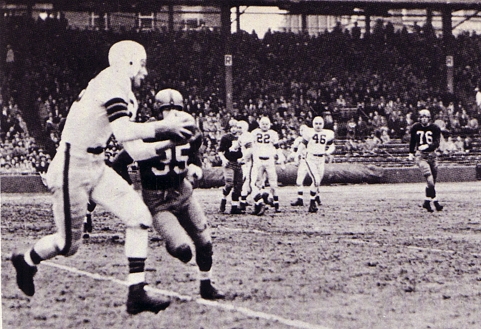 Ken Riley
Ken Riley 5'11" 181
Cornerback
Cincinnati Bengals
1969 - 1983
15 Seasons
207 Games Played
65 Interceptions
596 Yards
5 Touchdowns
4 All Pro Teams
Kenneth Jerome Riley was a 6th round draft pick of the Cincinnati Bengals in 1969. He was the 135th player picked overall. Riley was a 4 year starter at quarterback for Florida A&M University. Riley also earned a Rhodes Scholar Candidacy in college. He was his Senior Class President in both high school and college. Riley was recently named one of the 33 greatest high school football players in the history of the state of Florida, and is on the Florida High School Association All-Century Team. After retiring from the NFL, Riley returned to A&M to resurrect their athletics program. Riley was the head coach of the football team for 8 years from 1986 - 1993, then the athletic director of the school from 1993 - 2002. He was a two-time MEAC Coach of the Year and was named Black College Coach of the Year in 1988. Ken Riley is a member of the Florida A&M Hall of Fame, the Florida Sports Hall of Fame, the Tallahassee Sports Hall of Fame and the Polk County (Fla.) Sports Hall of Fame.
Cincinnati head coach Paul Brown converted Riley to the cornerback in training camp. Riley responded with 4 interceptions his rookie year. He returned 14 kickoffs at an average of 23.9 YPR. Riley also caught the only 2 passes of his career that year. Riley recorded 65 interceptions in his career, which was the fourth most in Pro Football history at the time of his retirement. The first three are all in Canton. At present time, Riley is 5th All Time. Riley languished on some mediocre teams in his era and was never given his due, despite his solid and spectacular efforts. In his 15 seasons, Riley recorded 3 or more interceptions in all but 3 years. In 1976, Riley snared 9 picks, a team record that stood for 30 years, for 141 yards. Riley returned 1 for a touchdown. He also set a team record by intercepting 3 passes in one game that season. Riley matched that feat again in 1982. In 1981 he recorded 5 interceptions as the Bengals went to Super Bowl XVI. In 1983, Riley recorded 8 interceptions for 2 touchdowns. He retired after that season. His 65 interceptions for 596 yards, and 5 touchdowns are all still Bengals records. He also recovered 18 fumbles in his career. Riley is also third all-time in NFL history with 141 INT return yards in a season. He was also as the Bengals’ defensive captain for eight seasons from 1976-83.
The Bengals had moderate success in the 1970's, but happened to be in a division that was dominated by the Pittsburgh Steelers. Still the Bengals had, perhaps, the best CB duo in the 70's with Riley and Lemar Parrish until 1977. It was usually the Bengals run defense or running game that caused them to come up short in that decade. Riley was a quiet, scholarly man who was made of substance and preferred to let his play be the flash to his persona. He rarely missed a game in his career, and was the constant defensive force for the Bengals throughout his entire career. While Ken Anderson, Parrish, and others got the press, Riley got the results needed for the Bengals to be able to compete weekly. His is a career many may have forgotten due to his workman-like approach, but have no illusions. Ken Riley is most definitely deserving of being inducted into the NFL Hall of Fame. It is long, long overdue.
Notable Players Drafted In 1969 * Denotes Canton Inductee
1. O.J. Simpson, RB, Buffalo *
4. Joe Greene, DT, Pittsburgh *
7. Ted Kwalick, TE, San Francisco
11. Bill Stanfill, DE, Miami
13. Fred Dryer, DE, NY Giants
16. Gene Washington, WR, San Francisco
19. Roger Wehrli, CB, St. Louis Cardinals *
20. Ron Johnson, RB, Cleveland
24. Calvin Hill, RB, Dallas
31. Bill Bergey, LB, Cincinnati
33. Ted Hendricks, LB, Baltimore Colts *
39. Ed White, OG, Minnesota
41. Bobby Douglass, QB, Chicago
48. Ed Podolak, RB, Kansas City
56. Jon Kolb, C, Pittsburgh
63. Eugene "Mercury" Morris, RB, Miami
69. Bill Bradley, S, Philadelphia
80. Bob Kuechenberg, OG, Philadelphia
93. Charlie Joiner, WR, Houston Oilers *
96. Roy Gerela, P, Houston
99. John Zook, DE, LA Rams
101. Jack Rudnay, C, Kansas City
139. Harold McLinton, LB, Washington
238. L.C. Greenwood, DE, Pittsburgh
262. Jeff Van Note, LB, Atlanta
273. John Fuqua, RB, NY Giants
337. Carl Mauck, LB, Baltimore
338. Steve O'Neal, P, NY Jets
















